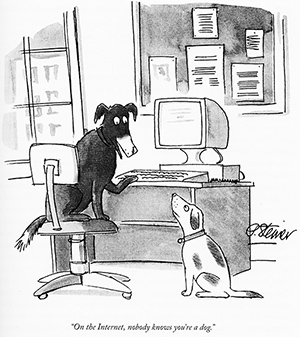On the Internet, nobody knows you're a dog

"On the Internet, nobody knows you're a dog" is an adage and Internet meme about Internet anonymity which began as a caption to a cartoon drawn by Peter Steiner, published in the July 5, 1993 issue of the American magazine The New Yorker.[1][2] The words are those of a large dog sitting on a chair at a desk, with a paw on the keyboard of the computer, speaking to a smaller dog sitting on the floor nearby.[3] Steiner had earned between $200,000 and $250,000 by 2013 from its reprinting, by which time it had become the cartoon most reproduced from The New Yorker.[1][4][5][6][7][8] The original was sold at auction for $175,000, setting a record for the highest price ever paid for a comic.[7][8]
History
Peter Steiner, a cartoonist and contributor to The New Yorker since 1979,[6] has said that although he did have an online account in 1993, he had felt no particular interest in the Internet then. He drew the cartoon only in the manner of a "make-up-a-caption" item, to which he recalled attaching no "profound" meaning, seeing that it had received little attention initially. He later stated that he felt as if he had created the "smiley face" when his cartoon took on a life of its own, and he "can't quite fathom that it's that widely known and recognized".[1]
On October 6, 2023, the original artwork was sold at a Heritage Auctions sale of illustration art for $175,000.[7][8]
Context
Once the exclusive domain of government engineers and academics, the Internet was by then becoming a subject of discussion in such general interest magazines as The New Yorker. Lotus Software founder and early Internet activist Mitch Kapor commented in a Time magazine article in 1993 that "the true sign that popular interest has reached critical mass came this summer when The New Yorker printed a cartoon showing two computer-savvy canines".[9]
According to Bob Mankoff, then The New Yorker's cartoon editor, "The cartoon resonated with our wariness about the facile façade that could be thrown up by anyone with a rudimentary knowledge of html."[10]
Implications
The cartoon symbolizes the liberation of one's Internet presence from popular prejudices. Sociologist Sherry Turkle elaborates: "You can be whoever you want to be. You can completely redefine yourself if you want. You don't have to worry about the slots other people put you in as much. They don't look at your body and make assumptions. They don't hear your accent and make assumptions. All they see are your words."[11] This was a view that Steiner says he shares.[7]
The cartoon conveys an understanding of Internet privacy that implies the ability to send and receive messages—or to create and maintain a website—behind a mask of anonymity. Lawrence Lessig suggests that "no one knows" because Internet protocols require no user to confirm their own identity. Although a local access point in, for example, a university may require identity confirmation, it holds such information privately, without embedding it in external Internet transactions.[12]
A study by Morahan-Martin and Schumacher (2000) on compulsive or troublesome Internet use discusses this phenomenon, suggesting the ability to represent one's self behind the mask of a computer screen may be part of the compulsion to go online.[13] The phrase may be taken "to mean that cyberspace will be liberatory because gender, race, age, looks, or even 'dogness' are potentially absent or alternatively fabricated or exaggerated with unchecked creative license for a multitude of purposes both legal and illegal", an understanding that echoed statements made in 1996 by John Gilmore, a key figure in the history of Usenet.[14] The phrase also indicates the ease of computer cross-dressing: representing oneself as of a different gender; age; race; social, cultural, or economic class, etc.[15] In a similar sense, "the freedom which the dog chooses to avail itself of, is the freedom to 'pass' as part of a privileged group; i.e., human computer users with access to the Internet".[15][16]
In popular culture

- The cartoon inspired the play Nobody Knows I'm a Dog by Alan David Perkins. The play revolves around six individuals, unable to communicate effectively with people in their lives, who nonetheless find the courage to socialize anonymously on the Internet.[1]
- Cyberdog, an Internet suite by Apple Inc., was named after this cartoon.[17]
- A cartoon by Kaamran Hafeez published in The New Yorker on February 23, 2015, features a similar pair of dogs watching their owner sitting at a computer, with one asking the other, "Remember when, on the Internet, nobody knew who you were?"[18]
- It has become a frequently used refrain in discussions about the Internet[19] and as such has become an Internet meme, perhaps iconic to Internet culture.[20]
See also
References
- ^ a b c d Fleishman, Glenn (December 14, 2000). "Cartoon Captures Spirit of the Internet". The New York Times. Archived from the original on December 29, 2017. Retrieved October 1, 2007.
- ^ Aikat, Debashis "Deb" (1993). "On the Internet, nobody knows you're a dog". University of North Carolina at Chapel Hill. Archived from the original on October 29, 2005. Retrieved February 8, 2019.
- ^ EURSOC Two (2007). "New Privacy Concerns". EURSOC. Archived from the original on January 26, 2009. Retrieved January 26, 2009.
- ^ "Everybody Knows You're a Dog / Boing Boing". boingboing.net. 17 October 2013. Archived from the original on 2019-03-28. Retrieved 2019-03-28.
- ^ Fleishman, Glenn (October 29, 1998). "New Yorker Cartoons to Go on Line". The New York Times. Archived from the original on October 22, 2008. Retrieved October 2, 2007.
- ^ a b "Brown's Guide to Georgia". brownsguides.com. January 2011. Archived from the original on 2014-03-12.
- ^ a b c d Berlinger, Max (October 22, 2023). "Auctions: The Most Reprinted 'New Yorker' Cartoon Fetches $175,000 at Auction—the Highest Price Ever Paid for a Single Comic". artnetnews. Artnet, artnet.com. Retrieved October 24, 2023.
The cartoon has been printed on mugs and T-shirts, and even inspired a 1995 play.
- ^ a b c "Peter Steiner (American, b. 1940). On The Internet, Nobody Knows You're A Dog". Heritage Auctions. October 6, 2023.
- ^ Elmer-DeWitt, Philip; Jackson, David S. & King, Wendy (December 6, 1993). "First Nation in Cyberspace". Time. Archived from the original on February 5, 2009. Retrieved March 21, 2009.
- ^ Cavna, Michael (July 31, 2013). "'Nobody Knows You're a Dog': As iconic Internet cartoon turns 20, creator Peter Steiner knows the joke rings as relevant as ever". Washington Post. Archived from the original on 30 August 2016. Retrieved 6 January 2015.
- ^ Hanna, B.; Nooy, Juliana De (2009). Learning Language and Culture Via Public Internet Discussion Forums. Springer. ISBN 9780230235823. Retrieved 4 June 2017.
- ^ Lessig, Lawrence (2006). Code: Version 2.0. New York: Basic Books. p. 35. ISBN 0-465-03914-6.
- ^ Taylor, Maxwell; Quayle, Ethel (2003). Child Pornography: An Internet Crime. New York: Psychology Press. p. 97. ISBN 1-58391-244-4.
- ^ Jordan, Tim (1999). "The Virtual Individual". Cyberpower: The Culture and Politics of Cyberspace and the Internet. New York: Routledge. p. 66. ISBN 0-415-17078-8.
- ^ a b Trend, David (2001). Reading Digital Culture. Malden, Massachusetts: Blackwell Publishing. pp. 226–7. ISBN 0-631-22302-9.
- ^ Singel, Ryan (September 6, 2007). "Fraudster Who Impersonated a Lawyer to Steal Domain Names Pleads Guilty to Wire Fraud". Wired. Archived from the original on October 21, 2008. Retrieved October 2, 2007.
- ^ Ticktin, Neil (February 1996). "Save Cyberdog!". MacTech. 12 (2). Archived from the original on April 19, 2012. Retrieved September 3, 2011.
- ^ Vidani, Peter (February 23, 2015). "The New Yorker - A cartoon by Kaamran Hafeez, from this week's..." The New Yorker. Archived from the original on September 20, 2016. Retrieved July 29, 2016 – via tumblr.com.
- ^ Friedman, Lester D. (2004). Cultural Sutures: Medicine and Media. Durham, N.C: Duke University Press. ISBN 0822332949. Archived from the original on 29 June 2019. Retrieved 4 June 2017.
- ^ Castro-Leon, Enrique; Harmon, Robert (December 22, 2016). Cloud as a Service: Understanding the Service Innovation Ecosystem. Apress. ISBN 9781484201039. Retrieved 4 June 2017.
Further reading
- Jones, Christopher R. (2004). "Nobody knows you're a dog". In Land, Ray & Bayne, Siân (eds.). Education in Cyberspace. New York: Routledge. 105 pages. ISBN 0-415-32882-9.
- Nielsen, Jakob (1995). Multimedia and Hypertext: The Internet and Beyond. San Diego: AP Professional. 172 pages. ISBN 978-0-12-518408-3.
- Nakamura, Lisa (2002). Cybertypes: Race, Ethnicity, and Identity on the Internet. New York: Routledge. 35 pages. ISBN 0-415-93837-6.
- The New Yorker Magazine; Malcolm Gladwell; et al. (October 30, 2012). The Big New Yorker Book of Dogs. Random House Publishing. ISBN 9780679644767.
- Schneider, Edgar (2003). Living the Good Life With Autism. London: Jessica Kingsley Publishers. 44 pages. ISBN 1-84310-712-0.
- Turkle, Sherry (1997). Life on the Screen: Identity in the Age of the Internet. New York: Simon & Schuster. 352 pages. ISBN 0-68483-348-4.
